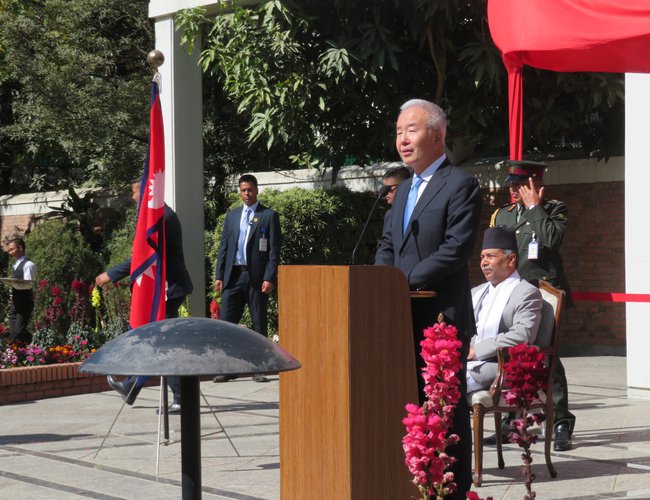
His Majesty will turn 65 on the 23rd of February. It is also a privilege for me to host this reception for the first time in Nepal after my arrival in early January.
Japan and Nepal have long-standing relations that can be traced back to the end of the 19th century when a Japanese Buddhist monk, KAWAGICH Ekai, visited Nepal in 1899 on his way to Tibet. In 1902, the Nepali government sent eight students to Japan to learn about Japanese development and technology. These early exchanges laid the foundation for our enduring relationship. His Majesty the Emperor also paid a state visit to Nepal when he was Crown Prince in 1987. Last year, the visit of the then Foreign Minister KAMIKAWA Yoko to Nepal in May further deepened our relationship.
Since 1969, for more than half a century, Japan has been a major development partner of Nepal. Our partnership has successfully implemented various projects and programs in many areas including infrastructure, disaster prevention, climate change, agriculture, healthcare, education, and capacity development. These projects and programs have involved a cumulative 226 billion yen (or 208 billion rupees) of grants, 147 billion yen (or 135 billion rupees) of concessional loans, nearly 6,000 Japanese experts and volunteers in Nepal, approximately 6,900 Nepali trainees in Japan, and 333 community projects in cooperation with various international organizations, NGOs, and municipalities.
Currently, Japan is working on a major tunnel project in the Nagdhunga area. I am pleased to know that the tunnel will be completed this year and is expected to be operational early next year.
After the major earthquake in 2015, Japan contributed to the reconstruction of 274 schools in the affected areas and historical heritage buildings in the Kathmandu Valley. In September last year, the Sindhuli highway, another major project Japan has been involved in, was severely damaged by heavy rainfall. The government of Japan is now seriously considering ways to improve the situation in cooperation with the government of Nepal.
As we look into the future, we warmly welcome Nepal’s participation in EXPO 2025 in Osaka, Kansai, starting from April this year. I believe that it will provide an opportunity for Japanese people to learn more about Nepal’s unique culture, natural beauty, and future potential, thereby promoting tourism, trade, investment, and people-to-people exchanges between our two countries.
In 2026, Japan and Nepal will celebrate the 70th anniversary of our diplomatic relations. We look forward to initiating discussions with various friends and friendship organizations on both sides on how to further promote our friendship during the year.
Recently, we have witnessed a rapid increase in the number of Nepali people in Japan. Currently, more than 200,000 Nepali people live in Japan as students, businesspersons, workers, and their families. It is expected that this trend will continue for some time, given the socio-economic situations in both countries. I hope Japan and Nepal can collaborate to make this new important element of our relations another opportunity to create positive impacts on both societies and strengthen the ties between the two peoples and countries.
In closing, I would like to express my sincere gratitude once again to The Right Honorable Vice President Yadav and all the distinguished guests for your valuable presence today. I would also like to thank the Japanese restaurants and companies in Kathmandu who have kindly contributed some stalls to this reception.
Maeda Toru is the newly arrived ambassador of Japan to Nepal. Excerpts of his statement delivered during the reception.













